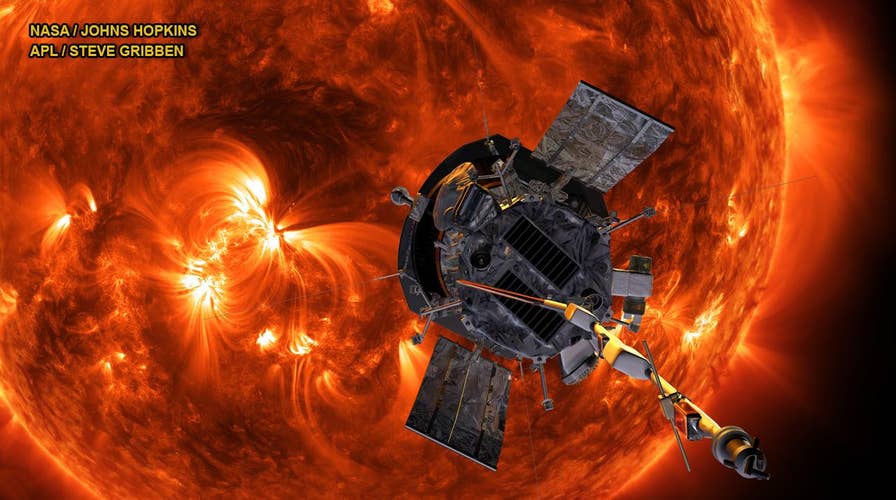NASA's Parker Solar Probe set to 'touch the Sun'
NASA is set to launch its Parker Solar Probe on a historic mission that will 'touch the Sun.' The solar probe will be the first spacecraft to fly through the Sun's corona, the outermost part of the star's atmosphere.
CAPE CANAVERAL – NASA is set to launch its Parker Solar Probe Saturday on a historic mission that will “touch the Sun.”
The solar probe will be the first spacecraft to fly through the Sun’s corona, the outermost part of the star’s atmosphere. “Parker Solar Probe will revolutionize our understanding of the Sun,” explains NASA, on its website.
"The coolest, hottest mission, baby, that's what it is," said Nicola Fox, the project scientist at Johns Hopkins University.
SOLAR ECLIPSE, CRASHING SPACECRAFT, VOLCANOES AND MORE: BIGGEST SCIENCE STORIES OF 2017
Parker will blast off aboard a United Launch Alliance Delta IV Heavy rocket from Space Launch Complex 37 at Cape Canaveral Air Force Station, Fla. The 65-minute launch window for the mission opens at 3:33 a.m. EDT on Aug. 11, 2018.
The probe will face “brutal” heat and radiation during an epic journey that will take it to within 3.8 million miles of the Sun’s surface, according to the space agency. This is seven times closer than the previous closest spacecraft, Helios 2, which came within 27 million miles of the Sun in 1976.
The average distance between the Sun and Earth is 93 million miles.
Parker must withstand heat of nearly 2,500 degrees Fahrenheit to complete its audacious mission. To achieve this, the probe will be protected by a special 4.5-inch-thick carbon-composite shield. Safe inside the spacecraft, however, the probe’s payload will be operating at room temperature.
Harnessing Venus’ gravity, Parker will complete seven flybys over seven years to gradually bring its orbit closer to the Sun. On its closest approach, the probe will be traveling at approximately 430,000 mph.
Scientists expect the $1.5 billion mission to shed light not only on our own dynamic Sun, but the billions of other yellow dwarf stars — and other types of stars — out there in the Milky Way and beyond. While granting us life, the Sun also has the power to disrupt spacecraft in orbit, and communications and electronics on Earth.
NASA NAMES NINE 'AMERICAN HERO' ASTRONAUTS FOR SPACEX, BOEING MISSIONS
Parker was designed and built by the Applied Physics Laboratory at Johns Hopkins University.
The probe, named after pioneering solar physicist Dr. Eugene Parker, will provide a wealth of invaluable data for scientists.
The Sun is the source of solar wind, a flow of ionized gases that stream past the Earth at more than a million miles an hour, the space agency explains. “Disturbances in the solar wind shake Earth's magnetic field and pump energy into the radiation belts, part of a set of changes in near-Earth space known as space weather,” it says. ”Space weather can change the orbits of satellites, shorten their lifetimes, or interfere with onboard electronics. The more we learn about what causes space weather – and how to predict it – the more we can protect the satellites we depend on.”
MASSIVE MARS DISCOVERY: ORGANIC MOLECULES 'FUNDAMENTAL TO OUR SEARCH FOR LIFE' FOUND BY NASA ROVER
NASA adds that solar wind dominates the space environment far beyond Earth. “As we send spacecraft and astronauts further and further from home, we must understand this space environment just as early seafarers needed to understand the ocean,” it explains.
The project was proposed in 1958 to a brand-new NASA, and "60 years later, and it's becoming a reality," said project manager Andy Driesman, also of Johns Hopkins, which designed and built the spacecraft. The technology for surviving such a close solar encounter, while still being light enough for flight, wasn't available until now.
Instruments on board Parker will study magnetic fields, plasma and energetic particles as well as image the solar wind.
The Sun’s corona, which can be seen during a total solar eclipse, is usually hidden by the bright light of the star’s surface. “That makes it difficult to see without using special instruments,” the space agency explains.
United Launch Alliance is also involved in NASA’s Commercial Crew program that will take American astronauts into space on missions launched from U.S. soil. Since the retirement of the space shuttle in 2011, the U.S. has been relying on Russian Soyuz rockets, launched from the Baikonur Cosmodrome in Kazakhstan, to get astronauts to the International Space Station.
Last week, NASA named the nine American astronauts that will crew the test flights and first missions of the Boeing CST-100 Starliner and SpaceX Crew Dragon spacecraft. The Starliner will launch atop a ULA Atlas V rocket.
The Associated Press contributed to this story. Follow James Rogers on Twitter @jamesjrogers

